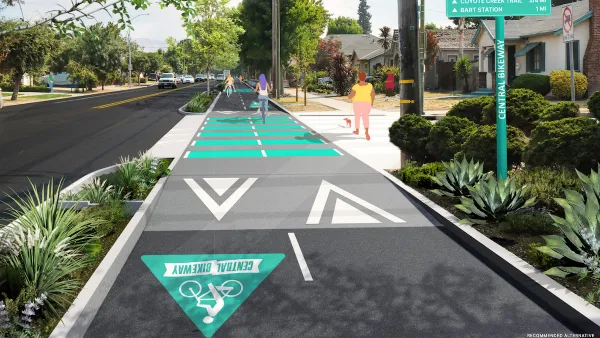For residents of many U.S. small towns and exurbs, the local Walmart offers a surprising benefit missing elsewhere in their communities: walkability.

Writing in Discourse Magazine, Addison Del Mastro compares the layout of a typical superstore with a traditional historic downtown, and finds some surprising similarities. While the vast majority of Walmarts and their ilk are located in car-oriented communities surrounded by seas of parking, their interior layouts oddly mirror the grid of a classic small town, Del Mastro writes.
“The idea of a commercial space aping the design of a city is somewhat familiar when it comes to the suburban shopping mall. Malls were famously designed after urban downtowns or shopping districts by the European-born architect Victor Gruen, who envisioned them not as churches of consumerism but as weather-free, and traffic-free, diminutive cities.” (More on that in Alexandra Lange’s book, Meet Me by the Fountain: An Inside History of the Mall.)
Walmart replicated this at massive scale. “And so what the big-box discount department store effectively did was consolidate and transpose almost every classic Main Street enterprise—clothing, toys, crafts, decor, electronics, hardware and groceries —and place them all under one roof, under one corporate enterprise, in a massive, car-oriented property on the edge of town.”
For Del Mastro, the car-free aspect is the most interesting. “By segregating the cars completely outside and making the ‘streets’ car-free—something often deemed suspect or radical when attempted in actual cities—the shopping experience becomes safer and more convenient to the customer.”
Ultimately, there is an important lesson to be learned from the behemoth often credited with killing small town economies. “If we could transpose the commercially vibrant walkability of a modern Walmart back to the downtowns it killed, those towns would be better off.” This shows that “despite the political framings and stereotypes around transportation and land use issues, the desirability of commerce in a walkable setting transcends political lines.” When stripped of its political baggage, people just like walkability.
FULL STORY: Walmart Didn’t Kill the Small Town, It Is the Small Town

Planetizen Federal Action Tracker
A weekly monitor of how Trump’s orders and actions are impacting planners and planning in America.

Silicon Valley ‘Bike Superhighway’ Awarded $14M State Grant
A Caltrans grant brings the 10-mile Central Bikeway project connecting Santa Clara and East San Jose closer to fruition.

Amtrak Cutting Jobs, Funding to High-Speed Rail
The agency plans to cut 10 percent of its workforce and has confirmed it will not fund new high-speed rail projects.

California Set to Increase Electric Truck Chargers by 25%
The California Transportation Commission approved funding for an additional 500 charging ports for electric trucks along some of the state’s busiest freight corridors.

21 Climate Resilience Projects Cancelled by the EPA
The federal government has pulled funding for at least 21 projects related to farming, food systems, and environmental justice to comply with one of Trump’s early executive orders.

Trump Executive Order on Homelessness Calls for Forced Institutionalization
The order seeks to remove legal precedents and consent decrees that prevent cities from moving unhoused people from the street to treatment centers.
Urban Design for Planners 1: Software Tools
This six-course series explores essential urban design concepts using open source software and equips planners with the tools they need to participate fully in the urban design process.
Planning for Universal Design
Learn the tools for implementing Universal Design in planning regulations.
Yukon Government
Caltrans
New Jersey Institute of Technology
Mpact (founded as Rail~Volution)
City of Camden Redevelopment Agency
City of Norman, Oklahoma
City of Portland
City of Laramie




























